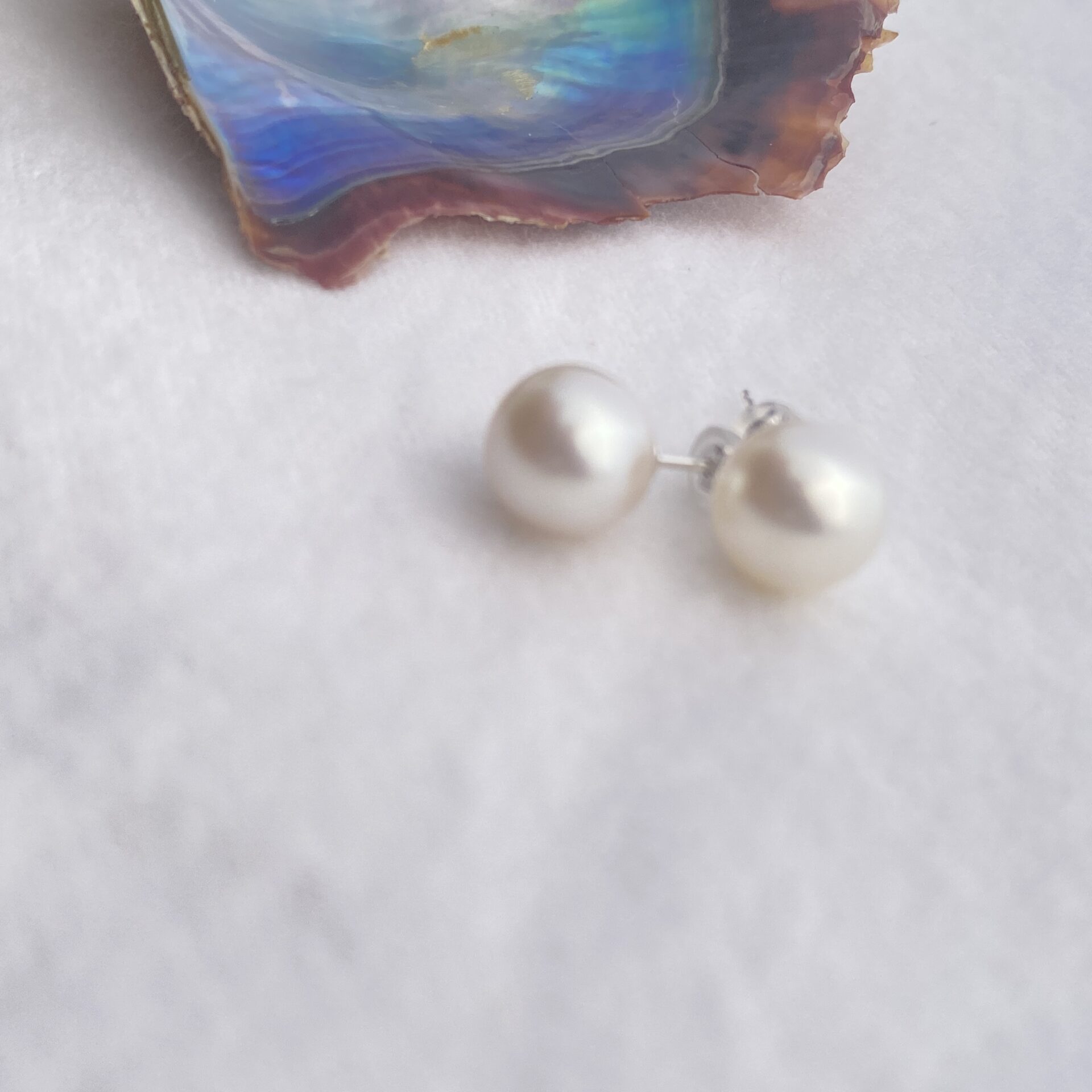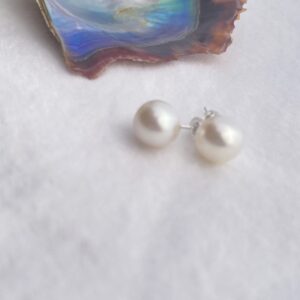These Sixty Series Akoya pearl earrings were created with pearls preserved for more than sixty years — a rare link to the early era of Japan’s cultured pearl history. Each pearl carries traces of time, holding within it the silent stories of nature, craftsmanship, and the generations that once cherished it.


遥か-Haruka – Sixty Series Akoya Pearl Earrings | Flower Jem
$150.91
1 in stock
Haruka
These Sixty Series Akoya pearl earrings, called “Haruka,” carry nearly a century of history.“Haruka” means “far away” — a name that reflects the deep history within these Akoya pearls. Cultured more than 60 years ago, they still shine with the quiet strength of time.
There is a kind of light that has quietly crossed time.
It is not merely decoration, but something that holds nearly a century of human endeavor — a presence that feels like memory itself.
I named this piece “Haruka,” a word that means “far away” or “distant past.” It is a piece that carries that memory gently to the ear.
The pearls used in this work were passed down from the great-grandson of Yasuie Tōdō, the inventor of pearl stain removal in 1922 and founder of Takahashi Pearl.
More than a century ago, Tōdō invested in pearl farming in Sukumo, Kōchi Prefecture, and was one of the main investors in the farm where the world’s first perfectly round cultured pearls were produced. The farm was destroyed by a flood in 1920, but the stain-removal technique he later invented became a foundation of modern pearl processing and is still widely used today.
These pearls were kept within the Tōdō family for decades and are estimated to be at least sixty years old. Their origins likely overlap with the period when pearl farming was still being carried out in Sukumo, and they were nurtured within that historical context.
They are not flawless, but their significance lies not only in their beauty, but also in the history they carry.
At Flower Jem, I call these pearls the “Sixty Series.”
If you would like to learn more about their background, please visit:
Akoya Pearls with a Century of History – The Sixty Collection Bracelet
This time, I am introducing a pair of stud earrings from this series, featuring pearls measuring 9.80 mm and 9.84 mm.
Although harvested more than sixty years ago, they remain in remarkably good condition. In the past, pearl cultivation often lasted not one or two years as it does today, but three or four years — sometimes even longer. Because of this, the nacre layers became thicker and more durable.
These pearls have a luster stronger than average. The surface is not perfectly mirror-like; there is a subtle undulation, and under magnification, one can see fine textures reminiscent of human skin. Despite this, the luster remains strong — and if they had been completely mirror-smooth, their brilliance would have been even more striking.
All pearls in the Sixty Series are untoned. This is not a rejection of toned pearls — it is simply my personal preference. I am drawn to softer shades, like the “cherry blossom” tones Japanese pearl dealers describe, somewhere between white and pale pink.
In some areas, faint white cloud-like traces can be seen on the surface. These are layers formed when the host oyster was unwell — secretions outside the normal nacre. If the oyster dies prematurely, the resulting pearls can be covered with a thick, paint-like white coating. Pearl dealers partly assess the quality of a harvest by the amount and thickness of such layers.
Pearls are harvested in December each year, but if thin white films are already visible during the November cleaning, it signals a problem: the oysters are weakening before harvest. On the other hand, if thick coatings are more common, it suggests they struggled earlier — around the summer — which is less critical. Akoya oysters grow best when seawater temperatures are between 23 and 28°C.
The pearls in these earrings also endured such hardships and still formed into a round shape. But of course, that was more than sixty years ago.
These pearls have not been bleached, but last year they underwent a preliminary process that removes less than one percent of internal impurities. This same treatment is also applied to natural blue pearls. It brightens the surface and elevates the luster by one grade. Until this treatment, the pearls had remained untouched for over sixty years, preserved within the Tōdō family.
For that reason, these pearls can be seen as both “vintage” and “not vintage” at the same time.
A Timeless Connection
More than just jewelry, these Sixty Series Akoya pearl earrings embody a historical lineage. Their story traces back to the early 20th century, when pioneering efforts in pearl cultivation transformed the future of the industry. From the forgotten beginnings in western Japan to the techniques still used today, the legacy continues — and with these earrings, that legacy becomes part of your story too.
Pearls of this kind cannot be reproduced or reordered. Once sold, this pair will never exist again. It is a piece of history that you can hold in your hand — and wear close to you.
For me, the value of the Sixty Series lies not only in their beauty but also in the time and stories behind them.
After Kokichi Mikimoto achieved success with half-round cultured pearls, the farm supported by the Tōdō family produced perfectly round pearls. This caused great excitement at the time, and in Osaka, they sold for astonishingly high prices. Had this continued, Sukumo might have become the world’s pearl capital. But only a few years later, a massive flood devastated the farm.
Tōdō later moved to Kobe and attempted many ventures, not all of them successful. One day, while walking with his daughter past a shrine, he suddenly conceived the idea of pearl bleaching. Soon after, the world’s first bleaching technique was born, and he became the founder of Takahashi Pearl.
When I worked for a pearl company, I had some dealings with Takahashi Pearl, but I knew nothing of this history at the time. Years later, I met Tōdō’s great-grandchild and received these pearls. Today, bleaching is nearly universal in pearl processing. Knowing that these pearls were born at the farm linked to the man who invented bleaching makes Sukumo appear as a “forgotten birthplace of pearls.”
Sukumo, located in southwestern Kōchi Prefecture, is also the hometown of John Manjiro, who was rescued by Americans after drifting at sea in 1841 and later traveled to the United States. About seventy-three years later, a pearl farm was established here.
The farm lasted only about five years before floods around 1915 to 1920 ended its operations, but the techniques and people from that short-lived endeavor deeply influenced the history of pearls that followed.
The farm was called Yodo Pearl. The person responsible for nucleus insertion was Masayo Fujita, the first to succeed in culturing perfectly round pearls. Tōdō was one of the farm’s main investors. Yodo Pearl soon disappeared under the floodwaters, but Fujita later collaborated with Mikimoto — Mikimoto providing capital, Fujita the technical expertise — which accelerated Mikimoto’s rise in the cultured-pearl industry.
Fujita went on to achieve success in freshwater pearl cultivation as well, becoming a leading figure in the field.
From this small farm in Sukumo, the story of pearls branched outward — into freshwater pearls, into Mikimoto’s enterprise, and into bleaching itself. Looking back through old records, I find countless fascinating stories. Seventy years ago, pearl researchers in Ise published monthly journals reporting their studies, and these archives remain accessible today. I intend to continue reading them and sharing their history little by little.
The name “Haruka” reflects this sense of memory reaching far back in time.
These pearls were born long before we can easily imagine. Their light carries layers of time that cannot be summed up by sixty years alone — and even now, they quietly continue to breathe.
This video shows the selection process of pearls from a 9 mm Sixty Series lot, specifically chosen for these earrings.
From 2:00:50 in this video, you can see the drilling and setting process for a pair of 9 mm Sixty Series pearls.
A – Nukumori, B – Tsuioku – Towa, D – Haruka, E – Kanata
Specifications
This pair of earrings features Akoya pearls measuring 9.80 mm and 9.84 mm. The findings are made of silver.
Pearls cultured more than sixty years ago have a distinct thickness and texture that differ from modern pearls, giving them a soft, natural glow when worn.
One-of-a-kind
These pearls can never be obtained again. They were formed by chance in nature and have remained preserved through the passage of time.
This encounter is like a single thread connecting the past and the present — and it will walk alongside you through your life.
Why This Piece Matters
Each pearl in this pair is truly one-of-a-kind — formed by nature more than six decades ago and carefully preserved within a single family for generations. Once sold, this pair will never exist again. It’s not a piece that can be reordered or reproduced. It’s a rare moment in time you can hold in your hand — and wear close to you.

Its story continues — with you.
Pearl bless you